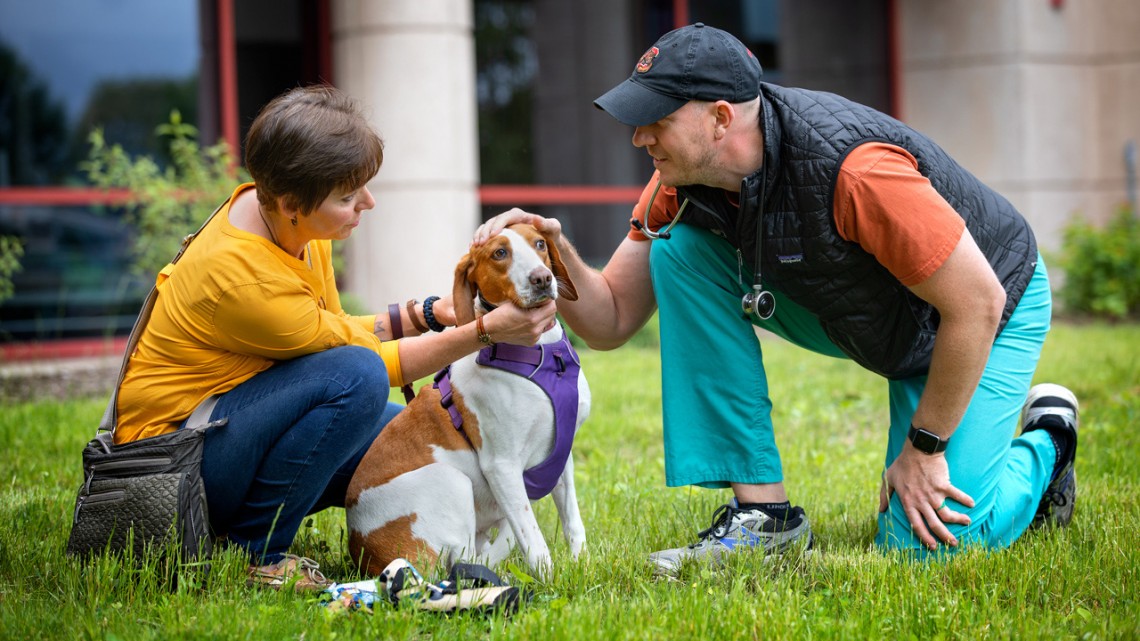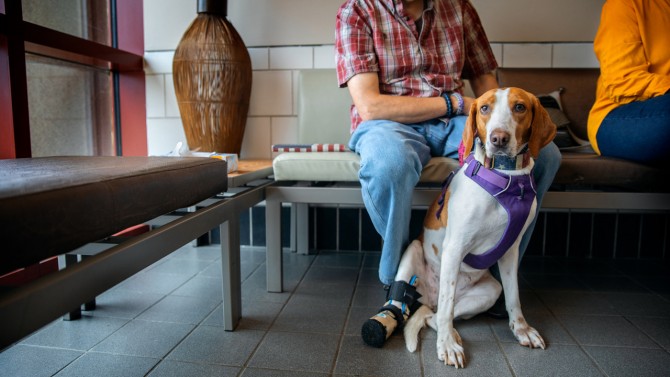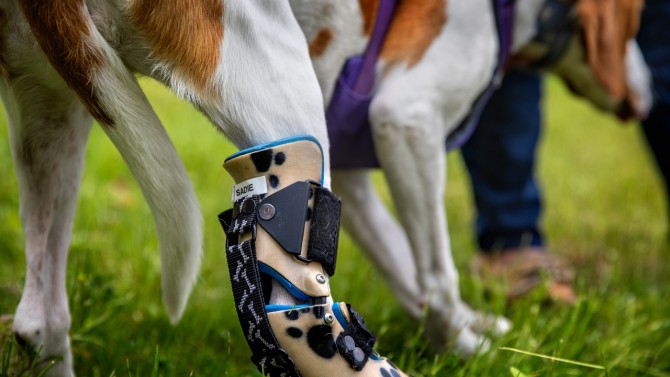
From left, Linda Hamilton, the dog control officer in the town of Chenango, New York, Sadie, and Chris Frye, assistant clinical professor of sports medicine and rehabilitation at the Cornell University Hospital for Animals.
Sadie perseveres with prosthetic paw
By Krishna Ramanujan
Sadie, an American foxhound, went missing from a hunt club on the West Virginia border in 2014. Over the next two-and-a-half years, she traveled close to 400 miles to upstate New York before being rescued in June 2017. Toward the end of that journey, she caught her right hind paw in a coyote trap and ended up losing it.
Fortunately, the story has a happy ending. Thanks to the care from her new owner and treatment from veterinarians at the Cornell University Hospital for Animals, Sadie was fitted this year with a prosthetic leg and is well on her way to thriving after an epic journey of survival.
On Jan. 10, 2017, Linda Hamilton, the dog control officer in the town of Chenango, New York, in Broome County, received a call reporting a stray brown and white hound with floppy ears was seen dragging a coyote trap on its right hind leg.
Between January and June last year, Hamilton worked tirelessly fielding reports of sightings in towns across Broome County. She learned that the dog was caught on a trail cam carrying the trap as early as December 2016, and by February 2017, a resident in Maine, New York, found the trap with Sadie’s foot in it. Hamilton built a humane enclosure trap with an electro-magnetic door and posted a few hundred flyers in areas where the dog had been sighted. But Sadie avoided people and traps and kept running.
“She was traveling about nine miles a day,” Hamilton said. “Everybody wanted to help her, but people have a hard time understanding that a dog is in survival mode at that point.”
In June 2017, Nicole Asher, owner of Buddha Dog Rescue & Recovery in Tuxedo Park, New York, who specializes in capturing trap-savvy dogs, drove to the Endicott area and assisted in rescuing Sadie by setting up an enclosure trap. A tag on her collar identified her as belonging to the West Virginia hunt club, which Hamilton called, but the club didn’t want her back. Soon thereafter, Hamilton adopted her.
“She had lost an upper canine,” Hamilton said, “probably trying to get out of the [coyote] trap, and had a tear in her tongue. She probably had a litter of puppies on the way.” And she had an infection of the uterus “that would have killed her” had she not been caught, Hamilton said.
In October 2017, Hamilton contacted Chris Frye, assistant clinical professor of sports medicine and rehabilitation at the Cornell University Hospital for Animals, to inquire about fitting Sadie with a prosthetic limb. Upon examination, he found that the bones of her rear hind leg were sharp and splintery from where she had chewed her paw off the trap, he said. The soft tissue covering the area was thin, and he noticed the site was painful to her.
“I knew if I fitted a prosthetic with a stump like that the bones would cause ulceration in the soft tissue, and all sorts of problems would evolve,” Frye said.
But he also found that Sadie was a perfect candidate for a prosthesis since her amputation had occurred below the ankle, leaving the joint, which provided an anchor that prevents the prosthesis from slipping.
Upon Frye’s recommendation, in February of this year, Julia Sumner, assistant professor of small animal surgery, successfully operated on the limb to smooth out the bones and fold the skin over to create a soft tissue pad. Once the foot had healed, Frye measured the limb, took a molding and had the prosthetic made.
“It couldn’t be any better than it is,” said Frye, of the way her leg has healed and how well she has taken to the prosthesis. He added that Sadie was a perfect dog for this type of treatment, with the right attitude and the right family.
“You have to have the right family and a dog that can tolerate surgery and bandaging and cast moldings and fittings and slinging the limb if necessary,” Frye said. “Then you warn the owner, we could do all of it, we could have a perfect fitting with great alignment over the joint, and we may have a dog that doesn’t want to use the thing.”
Throughout the process, Sadie has been “the best patient in the world,” Hamilton said. After regular appointments, physical therapy and slowly increasing the amount of time each day that Sadie wears the prosthetic, she is taking well to it, Hamilton said. She walks normally on it; she recently swam with it; and when she’s romping around Hamilton’s enclosed backyard with her three other dogs, she runs on it.
“She used it running the other day,” said Jamie Szenher, Hamilton’s partner and one of Sadie’s owners. He heard a sound, “ba, ba, ba, ba, ba,” of Sadie’s prosthetic rapping on the ground outside. “We call her thumper,” he said.
Media Contact
Get Cornell news delivered right to your inbox.
Subscribe


